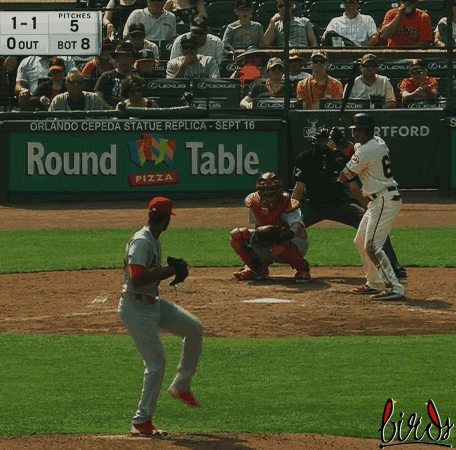
Sandy Alcantara's rise through the system has been understandably headlined by his potential-for-triple-digits fastball. While the 22-year-old was a starter for the majority of his minor league appearances (68 out of 72, to be exact), current starting pitching depth at the big league level slates him into a bullpen role for the indefinite future. And out of the bullpen, one can reasonably expect a triple-digits fireballer to simplify his approach -- turning to the fastball to blow away hitters with regularity.
Well, as we learned during Alcantara's eight relief appearances last September, this isn't presently the case for the young righty. The tough, but fair scouting report long associated with Alcantara has been that his fastball velocity actually plays down from the radar gun reading due to a lack of movement and a lack of command. For what it's worth, this wasn't much of an issue for Alcantara until he climbed the organizational ladder and began facing stiffer competition. In fact, I believe this reality helped contribute to the emergence of his sinker -- a pitch that experiences an ample amount of horizontal movement (while still maintaining high-90's velocity).
Before going further, let's take a closer look at the PitchF/x basics behind Alcantara's repertoire (courtesy of BrooksBaseball.net):

First and foremost, this is, by no means, the typical pitch mix you see from a relief pitcher. Up to this point professionally, Alcantara's experience is as a starting pitcher, so, just as you'd expect, he still possesses a starting pitcher repertoire. Yet, at this stage in his development plus the current construction of the MLB roster, he is needed as a relief pitcher.
Fortunately, relief pitcher "roles" appear to be changing (finally!). The best relievers are being called upon in high-leverage situations against the opponent's best hitters (yes, even if this situation occurs before the 9th). At times, these same relievers are being asked to record more than the usual three outs. With these in mind, a starting pitcher's repertoire out of the bullpen can actually serve as a weapon, not at a hindrance. Now, throwing more types of pitches, just to throw more types of pitches isn't a guaranteed benefit. But as you can see in the table above, coupled with GIFs below, this isn't the case for Alcantara.
Each one of his pitch types possess the potential for being consistently effective, especially once he masters the art of pitch sequencing (i.e. changeup down and away followed by fastball up and in). He throws pitches in the high-90's (fourseamer, sinker), the low-90's (changeup), the mid- to high-80's (slider), and the low 80's (curveball; if this pitch carries over from the Fall League, that is). He can yield over a foot of arm-side movement (sinker) as well as nearly six inches of glove-side movement (slider). Long story short, in terms of repertoire quality and complexity, only two Cardinals can truly match Alcantara: Carlos Martinez and Alex Reyes.
As is the case with most of my posts, it is time for some specific case analyses. And yes, we are ever so fortunate to have @cardinalsgifs back so that visuals can provide us all with evidence for the points I am trying to make.
Slider-changeup sequence to Buster Posey (BrooksBaseball At Bat)

After failing to retire two of the first three MLB hitters he faced, Alcantara was stacked up against one of the league's best hitters in Buster Posey (career 135 wRC+). With over 4,000 documented plate appearances, we know that Posey mashes both fastballs and changeups -- two pitches that even the most elementary scouting report would have on the 22-year-old Alcantara.
Well, just as you'd expect, Posey faced only three pitches in this strike out -- a called-strike slider (82.9 MPH), a called-strike slider (84.9 MPH), and a swinging-strike changeup (91.4 MPH). Certainly, game-calling master Yadier Molina played a role in this three-pitch strikeout sequence, but Alcantara still had to execute. Posey's swing on strike three -- remember, a changeup masher -- shows us that Alcantara had zero difficulty executing here.
Changeup-fourseamer sequence to Gorkys Hernandez (Brooks Baseball At Bat)

While the release points don't match up very well (release point consistency is typically a work in progress for pitchers struggling with command), this popout sequence is filthy. If you follow me on Twitter, you know how frequently I stress the importance of going up and in with the fourseamer -- particularly if it is of the 99.5 MPH (red trail) variety.
Well, for a righty facing a righty, the very best way to set up a fastball up and in is by burying a changeup down and in. Alcantara does exactly that with the 90.4 MPH changeup (blue trail) down and below the zone. Heck, the strike two changeup was so effective that it allowed Alcantara to get away with not perfectly locating jamshot-inducing fourseamer.
Changeup-sinker sequence to Hernan Perez (BrooksBaseball At Bat)

Pitch tunneling -- while a relatively new topic discussed by baseball analysts -- has been a weapon utilized by pitchers since the game's inception. As you can see, Alcantara does a great job with the approach here -- starting Perez off with an 89 MPH changeup (blue trail) for strike one and a 98.4 MPH sinker (green trail) for strike two.
In order to effectively tunnel pitches with such a velocity difference (9.4 MPH here), the pitcher must set a higher target for his fastball than his changeup, as the faster pitch will not have as much time to drop as the slower pitch (plus, spin differences, but we will leave that to the physics experts).
Fortunately, from a pitch sequencing standpoint, this is perfect as pitchers should already be aiming low in the zone with their changeups and higher in the zone with their fastballs. While strike two was dangerously close to middle-middle, it's clear Perez's timing was disrupted by Alcantara -- ultimately leading to a harmless take for strike two.
Overlaid version versus Perez

Ever since the introduction of the Yu Darvish five-pitch overlay GIF, I have been asking @cardinalsgifs to make some of his own. I may be biased, but his are considerably better than the other ones I've seen. His incorporation of trails and his perfect alignment of the two pitches gives us a better grasp at what the hitter sees from the batter's box.
Remember, any time something in the background blurs should serve as an indication of imperfect alignment. If we are going to laud a pitcher's ability to match release points, we must first make sure we aren't cutting corners to prove our point.
Abstract version versus Perez

And finally, the abstract versions. These are the best, in my opinion. Remove all of the distractions and just appreciate the flight paths of the respective pitches. As I said earlier, Alcantara tunnels these two pitches perfectly.
Bottom line
Alcantara is a very exciting young pitcher. No doubt about that. But, please, don't be fooled by preliminary scouting reports that he is primarily a fastball pitcher. In fact, as I hope to have shown in this post, he is quite the opposite. His offspeed stuff can be just as effective, and it perfectly complements his electric fastball(s). When he develops even just a little more command, I see a 1.5-2 fWAR super reliever, year in and year out.
As always, credit to the great @cardinalsgifs and the indispensable BrooksBaseball.net for their contributions to this post.

